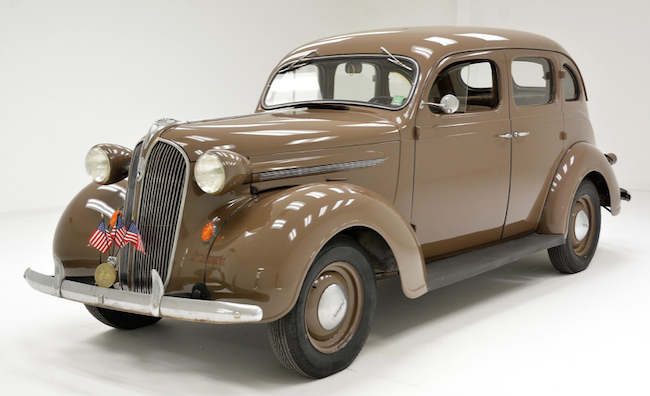Aside from the Airflow era, the Corporation's brands all used the same basic bodies at least from 1935 through 1952. So why feature Plymouth in today's post? Because its strong sales and importance to Chrysler's income make it worth examining. Clearly, engineering features were key to Plymouth's success during the late Great Depression years, but styling could not be ignored.
Images of four-door sedans below are mostly of for-sale cars.
1934 Plymouth
Non-Airflow Chrysler Corporation cars were redesigned as Airstreams for 1935, as I wrote here. Above is a pre-Airstream Plymouth to set the stage. Basically boxy, but the grille and windshield are slightly slanted and the fenders have modest skirts -- typical early '30 features hinting at the "streamlining" to come.
1935 Plymouth - Mecum auction photo
An Airstream Plymouth. More rounded and with a built-in trunk in this example. The chrome circles on the hood air vents are a distinctive feature seen only for the '35 model year. I wonder if Chrysler's styling staff thought them too static in the new era of streamlining.
1936 Plymouth DeLuxe
Those circles are gone, but otherwise this side view of a 1936 model is nearly the same as that in the previous image. This car has a slightly longer passenger compartment, as can seen comparing the aft side windows and shaping of the cars' rears.
1937 Plymouth DeLuxe
Some sources state that 1937s got a complete redesign, but I'm not sure of that. Indeed, the front clip is different (compare fenders and hood cutlines). So is the body abaft of the C-pillar. But the doors have the same framing and hinges, leading me to wonder if parts of the 1936 body were carried over.
1938 Plymouth - Mecum photo
During the 1930s, American facelifts included revisions to hood air vent décor. Otherwise, this car looks the same as the 1937 model.
1939 Plymouth
In this 2015 post I wondered if the "redesigned" Chrysler line was actually a case of a major facelift. Since then, I've come across some sources confirming my speculation. Even in that post I decided that Plymouths retained 1938 bodies aft of the cowling and revised windshield.
1934 Plymouth
American facelifts and redesigns into the 1960s and even beyond included changes to a car's grille -- its public face. The 1934 Plymouth grille featured a mild "shovel nose" and thin, vertical bars.
1935 Plymouth - Mecum photo
The Airstream redesign retained vertical bars, but now they are painted black. A central vertical chrome bar and a few horizontal bars are added and the Plymouth crest is restyled.
1936 Plymouth - Mecum photo
The '36 facelift reverted to thin, chromed vertical bars. Added was a solid vertical central bar painted body color.
1937 Plymouth
The more rounded 1937 styling and grille design fashion resulted in a modest bulged "fencer's mask" grille shape. The central body color strip is narrower and has chromed trim added.
1938 Plymouth - Mecum photo
The frontal facelift was modest for 1938. The vertical grille strip was retained, and more chrome added. New are those small chrome strips on the front "catwalk" area.
1939 Plymouth
The front clip was totally restyled for 1939. No trace of previous frontal themes such as thin, chrome vertical bars can be found.












1 comment:
I didn't use to care much about 1930's cars but now I find their evolution fascinating. It was the period of going from evolved horseless carriage to modern car, although the real last step didn't come to the mainstream until cars like the 1949 Ford. When I was a kid in the 50's I thought the few remaining 30's cars with the smoothed in but clearly conceptually an added tumor trunks were odd but now I get it. Trunks in cars evolved from...trunks. You can see it happening in these Plymouths.
Post a Comment